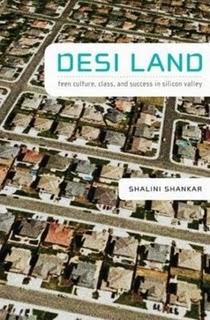Desi Land: Teen Culture, Class, and Success in Silicon Valley

Desi Land, Shalini Shankar’s ethnographic exploration of Desi teenagers in Silicon Valley during the late 1990s, is a fascinating look at South Asian American youth culture at a pivotal moment in modern American history.
The setting of the book makes it particularly compelling: California during the dot-com boom, when a confluence of "model minorities" are populating an increasingly profitable and technologically advanced work force. The combination of South Asian economic liberalization and American cultural capital creates a generation of Desi Land teenagers who are consumers of both traditional American pop culture and increasingly popular Bollywood and other South Asian music and movies. The teenagers deal with both pressure to be Americanized and encouragement (and desire) to express their cultural identities, with the caveat that they fit neatly into school-sponsored "Cultural Days" and do not disturb the white hegemony of their schools or communities.
The highly particular nature of this book belies its richness; Shankar delves deeply into the interplay of race, class, gender and social status. Desi Land determines its subjects' class in social and economic contexts, and defines teens as either middle class or upper middle class according to a set of criteria that includes "the type of work their parents do, whether both parents work, and their parents' level of education, English proficiency, neighborhood, home, cars, and lifestyle." The students are also defined by the terms "FOBby" (from the acronym for "fresh off the boat") or "popular," depending on their social standing at school. Gender also plays a pivotal role in the life experiences of the teens in Desi Land, and Shankar does an admirable, if understated, job of relating the additional set of conflicting expectations placed on the young women she interviews.
Shankar sympathetically recounts the teens' experiences in schools, family life, social and religious activities, and romantic relationships, as well as their hopes and dreams for the future, all with a researcher’s eye for patterns of behavior and belief, and a fellow South Asian's firsthand understanding and empathetic detail. This book’s vibrancy and immediacy, even a decade later, make it an absorbing read for anyone interested in cultural studies.
Wonderful, very intelligent review! And I think timely considering our current debates on immigration, what it means to be American, and other popular media depictions of the immigrant experience(most specifically, Clint Eastwood's Gran Torino).